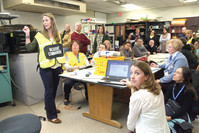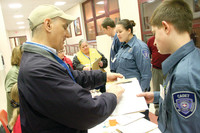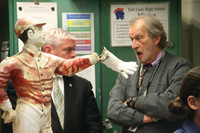It’s not a scene that anyone ever expects to happen, but if a number of people were to be effected by a release of anthrax, there would be the need to identify those people and treat them as …
This item is available in full to subscribers.
We have recently launched a new and improved website. To continue reading, you will need to either log into your subscriber account, or purchase a new subscription.
If you are a current print subscriber, you can set up a free website account by clicking here.
Otherwise, click here to view your options for subscribing.
Please log in to continue |
|



It’s not a scene that anyone ever expects to happen, but if a number of people were to be effected by a release of anthrax, there would be the need to identify those people and treat them as quickly as possible with antibiotics.
“Anthrax is the worst-case scenario,” Brittan Bates-Manni, of the Department of Health’s Center for Emergency Preparedness and Response, told the police, firefighters, other city employees and volunteers who filled a Toll Gate classroom Thursday evening. “We know we’re going to lose some lives.”
Fortunately, there was no anthrax, and no lives were lost. But a lot of time was spent simulating how to respond when the state is faced with a situation demanding the distribution of medication and vaccines to a large population as quickly as possible.
Toll Gate High School is one of four designated points of dispensing, or PODs, in the city and one of 69 statewide. Bates-Manni estimated 100 volunteers are needed per shift to operate a POD, meaning if there was an emergency involving the entire city, 1,200 volunteers would be required.
For Thursday’s training, there were about 100 from Warwick and West Warwick. Representatives from the two municipalities switched roles, with one group acting as citizens seeking the medication while the others filled the roles of screening citizens, having them complete the required paperwork and finally issuing vials, which would have contained antibiotics had anthrax been detected. The objective of the exercise was to give municipal employees and volunteers the hands-on training should an actual POD activation occur.
Bates-Manni described anthrax as the worst-case scenario because the symptoms of those who have been exposed to the illness are similar to the flu. It is not easy to detect. Also, it is highly likely anthrax would be related to a terrorist attack, therefore lending another dimension to the incident and the response.
But she said that PODs have proven highly efficient in getting out the H1N1 flu vaccination and responding to incidents such as the outbreak of meningitis several years ago at Greenwood School.
After the classroom briefing – during which volunteers sat on tables and the floor for a lack of seats – teams moved into their positions. There was a preponderance of paperwork and a good deal of checking over forms and asking questions before those playing the role of citizens – most were Warwick Police Cadets – moved on to get their empty bottles of meds.
It gave reason to wonder, if it took so long to process about 50, what would happen if there were hundreds and hundreds. Bates-Manni said there were to be more stations and more people.
It’s not a day to be welcomed, but should that emergency occur there is a plan and a team.
Bates-Manni said the Department of Health conducts about 10 POD training sessions a year. Thursday was Warwick’s turn.
Medical and non-medical volunteers are needed at PODs. More information is available at www.riema.ri.gov/response/local/index.php.
Comments
No comments on this item Please log in to comment by clicking here